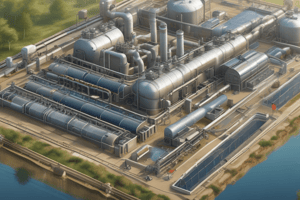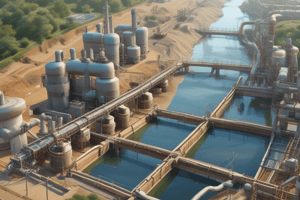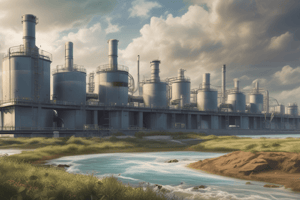Podcast
Questions and Answers
EASY What is the primary purpose of removing suspended solids in water treatment?
EASY What is the primary purpose of removing suspended solids in water treatment?
- To improve water clarity
- To remove dissolved ions
- To reduce disinfection costs (correct)
- To remove heavy metals
What is the size of suspended solids that can be removed in the first stage of water treatment?
What is the size of suspended solids that can be removed in the first stage of water treatment?
- Less than 1 micron
- Exactly 2 microns
- Greater than 2 microns (correct)
- Less than 0.5 microns
What happens to suspended solids if not removed in water treatment?
What happens to suspended solids if not removed in water treatment?
- They are not affected by gravity
- They dissolve as ions
- They float to the surface
- They cause deposits, erosion, and plugging of equipment (correct)
What type of water is likely to have high levels of suspended solids?
What type of water is likely to have high levels of suspended solids?
What is the purpose of a settling pond or basin?
What is the purpose of a settling pond or basin?
How do clarifiers differ from settling ponds?
How do clarifiers differ from settling ponds?
What is the typical residence time for water in a clarifier?
What is the typical residence time for water in a clarifier?
How is water introduced in a typical clarifier?
How is water introduced in a typical clarifier?
What is the primary function of the filter in the treatment process?
What is the primary function of the filter in the treatment process?
What happens to the pressure drop across the filter as it screens out more solids?
What happens to the pressure drop across the filter as it screens out more solids?
What is the primary use of activated carbon filters in industry?
What is the primary use of activated carbon filters in industry?
What happens to the chlorines in water when they pass through an activated carbon filter?
What happens to the chlorines in water when they pass through an activated carbon filter?
What is the result of heating carbonaceous material to about 1000°C with steam?
What is the result of heating carbonaceous material to about 1000°C with steam?
What is the purpose of backwashing and regenerating activated carbon filters?
What is the purpose of backwashing and regenerating activated carbon filters?
What is the unique property of activated carbon that makes it useful for adsorption?
What is the unique property of activated carbon that makes it useful for adsorption?
What is the equivalent surface area of one teaspoon of activated carbon?
What is the equivalent surface area of one teaspoon of activated carbon?
What is the purpose of adding alum or synthetic polymer coagulant in the clarifier?
What is the purpose of adding alum or synthetic polymer coagulant in the clarifier?
What is the main function of a clarifier?
What is the main function of a clarifier?
What type of particles are less than 1 μm in size and carry a slight electric charge?
What type of particles are less than 1 μm in size and carry a slight electric charge?
What is the purpose of the rake in the clarifier?
What is the purpose of the rake in the clarifier?
What is the purpose of the filter medium in a pressure filter?
What is the purpose of the filter medium in a pressure filter?
What is the consequence of inadequate backwash flow in a filter?
What is the consequence of inadequate backwash flow in a filter?
What is the purpose of the filter-aid in a filter-aid tubular filter?
What is the purpose of the filter-aid in a filter-aid tubular filter?
What is the purpose of the compressed air in the upper part of the filter housing in a filter-aid tubular filter?
What is the purpose of the compressed air in the upper part of the filter housing in a filter-aid tubular filter?
What type of filters are similar to an oil filter in an automotive engine?
What type of filters are similar to an oil filter in an automotive engine?
What is the consequence of excessive backwash flow in a filter?
What is the consequence of excessive backwash flow in a filter?
MEDIUM What is the primary purpose of adding alum or a synthetic polymer coagulant in the clarifier?
MEDIUM What is the primary purpose of adding alum or a synthetic polymer coagulant in the clarifier?
What is the function of the rake in the clarifier?
What is the function of the rake in the clarifier?
What is the purpose of the filter medium in a pressure filter?
What is the purpose of the filter medium in a pressure filter?
What happens to the filter cake in a filter-aid tubular filter when it needs to be replaced?
What happens to the filter cake in a filter-aid tubular filter when it needs to be replaced?
What is the purpose of the compressed air in the upper part of the filter housing in a filter-aid tubular filter?
What is the purpose of the compressed air in the upper part of the filter housing in a filter-aid tubular filter?
What is the consequence of inadequate backwash flow in a filter?
What is the consequence of inadequate backwash flow in a filter?
What is the purpose of a clarifier in water treatment?
What is the purpose of a clarifier in water treatment?
What type of particles are less than 1 μm in size and carry a slight electric charge?
What type of particles are less than 1 μm in size and carry a slight electric charge?
What is the result of excessive backwash flow in a filter?
What is the result of excessive backwash flow in a filter?
What type of filters are similar to an oil filter in an automotive engine?
What type of filters are similar to an oil filter in an automotive engine?
What is the primary purpose of the filter in the treatment process?
What is the primary purpose of the filter in the treatment process?
What happens to the water as it passes through the filter?
What happens to the water as it passes through the filter?
What is the purpose of monitoring the pressure drop across the filter?
What is the purpose of monitoring the pressure drop across the filter?
What is the primary use of activated carbon filters in water treatment?
What is the primary use of activated carbon filters in water treatment?
What is the result of adsorption of organics onto the activated carbon?
What is the result of adsorption of organics onto the activated carbon?
What is the unique property of activated carbon that makes it useful for adsorption?
What is the unique property of activated carbon that makes it useful for adsorption?
What is the purpose of backwashing and regenerating activated carbon filters?
What is the purpose of backwashing and regenerating activated carbon filters?
What happens to the carbon atoms during the production of activated carbon?
What happens to the carbon atoms during the production of activated carbon?
What is the primary benefit of removing suspended solids in the first stage of water treatment?
What is the primary benefit of removing suspended solids in the first stage of water treatment?
How do suspended solids behave in water?
How do suspended solids behave in water?
What is the primary difference between a settling pond and a clarifier?
What is the primary difference between a settling pond and a clarifier?
Why is filtration used to remove suspended solids from groundwater?
Why is filtration used to remove suspended solids from groundwater?
What is the purpose of the continuous removal of solids deposited by sedimentation in a clarifier?
What is the purpose of the continuous removal of solids deposited by sedimentation in a clarifier?
What happens to the suspended solids in a settling pond or clarifier?
What happens to the suspended solids in a settling pond or clarifier?
Why is it necessary to remove suspended solids from water?
Why is it necessary to remove suspended solids from water?
What is the result of water flowing through a settling pond or clarifier?
What is the result of water flowing through a settling pond or clarifier?
HARD What is the primary benefit of removing suspended solids in the first stage of water treatment?
HARD What is the primary benefit of removing suspended solids in the first stage of water treatment?
What is the primary purpose of a clarifier?
What is the primary purpose of a clarifier?
What is the primary difference between a settling pond and a clarifier?
What is the primary difference between a settling pond and a clarifier?
Why is filtration used to remove suspended solids from groundwater?
Why is filtration used to remove suspended solids from groundwater?
What happens to suspended solids in a settling pond or clarifier?
What happens to suspended solids in a settling pond or clarifier?
What is the primary purpose of a settling pond or basin?
What is the primary purpose of a settling pond or basin?
What happens to the pressure drop across a filter as it screens out more solids?
What happens to the pressure drop across a filter as it screens out more solids?
What is the primary benefit of removing suspended solids in the first stage of water treatment?
What is the primary benefit of removing suspended solids in the first stage of water treatment?
What is the primary mechanism by which activated carbon filters remove taste or odor from water?
What is the primary mechanism by which activated carbon filters remove taste or odor from water?
What is the primary advantage of using activated carbon filters in industry?
What is the primary advantage of using activated carbon filters in industry?
What is the primary reason why filters need to be replaced in the water treatment process?
What is the primary reason why filters need to be replaced in the water treatment process?
What is the primary purpose of heating carbonaceous material to about 1000°C with steam?
What is the primary purpose of heating carbonaceous material to about 1000°C with steam?
How does the filter material catch suspended solids in the water treatment process?
How does the filter material catch suspended solids in the water treatment process?
What is the primary benefit of using filters in the water treatment process?
What is the primary benefit of using filters in the water treatment process?
What is the primary purpose of monitoring the pressure drop across the filter?
What is the primary purpose of monitoring the pressure drop across the filter?
What is the primary advantage of using activated carbon filters in water treatment?
What is the primary advantage of using activated carbon filters in water treatment?
What is the primary reason why colloidal particles are difficult to remove in a clarifier?
What is the primary reason why colloidal particles are difficult to remove in a clarifier?
What is the purpose of the distribution plate in a pressure filter?
What is the purpose of the distribution plate in a pressure filter?
What happens to the filter cake in a filter-aid tubular filter when it needs to be replaced?
What happens to the filter cake in a filter-aid tubular filter when it needs to be replaced?
What is the primary advantage of using a filter-aid tubular filter over a pressure filter?
What is the primary advantage of using a filter-aid tubular filter over a pressure filter?
What is the consequence of excessive backwash flow in a pressure filter?
What is the consequence of excessive backwash flow in a pressure filter?
What is the primary purpose of adding a coagulant to the water in a clarifier?
What is the primary purpose of adding a coagulant to the water in a clarifier?
What is the purpose of the compressed air in the upper part of the filter housing in a filter-aid tubular filter?
What is the purpose of the compressed air in the upper part of the filter housing in a filter-aid tubular filter?
What is the primary difference between a cartridge filter and a pressure filter?
What is the primary difference between a cartridge filter and a pressure filter?
What is the consequence of inadequate backwash flow in a pressure filter?
What is the consequence of inadequate backwash flow in a pressure filter?
What is the primary purpose of using a clarifier in water treatment?
What is the primary purpose of using a clarifier in water treatment?
Flashcards are hidden until you start studying
Study Notes
Water Treatment Stage 1: Removal of Suspended Solids
- Suspended solids are particles greater than 2 microns that do not dissolve as ions and can be removed by gravity.
- Removing suspended solids also removes other harmful substances like heavy metals and reduces treatment costs.
- Suspended solids can cause operational issues like deposits, erosion, and plugging of equipment if not removed.
Settling Pond/Basin
- A settling pond or basin slows or delays the velocity of water, allowing suspended solids to settle to the bottom by gravity.
- Examples of common settling basins are cooling water basins and inlet water basins.
Clarifier
- A clarifier is a large settling tank that uses gravity to settle out particles.
- Clarifiers have features that promote the continuous removal of solids deposited by sedimentation.
- Residence time for water in a clarifier is around an hour or two, compared to a number of days for a typical settling pond.
- Water flows from the center of the clarifier to the bottom, then upwards to the weirs, and particles settle out and are removed by a rake.
Coagulation
- Colloidal particles (less than 1 μm in size) can be difficult to remove in a clarifier due to their slight electric charge.
- Alum (aluminum sulfate) or a synthetic polymer coagulant can be added to neutralize the particles, allowing them to combine and settle to the bottom of the clarifier.
Filtration
- Filtration is used to remove the last of the suspended particles after initial removal of suspended solids.
- Common types of filters include pressure filters, filter-aid tubular filters, cartridge filters, and activated carbon filters.
Pressure Filter
- A pressure filter has a filter medium (usually sand, anthracite coal, or calcite) that the water flows through.
- Suspended particles adhere to the surface of the medium and get trapped in pores.
- The filtered water is collected in the under-bed collection system.
- Filters become plugged with suspended particles over time and must be backwashed.
Filter-Aid Tubular Filter
- A filter-aid tubular filter consists of a closed cylindrical housing with screen-type cylindrical tubes covered in Dacron or polyethylene filter cloth.
- A slurry of filter-aid (usually diatomaceous earth or volcanic ash) is fed through the inlet at the beginning of the filter cycle.
- The filter-aid pre-coats the tubes, and additional filter cake forms, increasing filtration effectiveness.
- Backwashing involves closing the inlet and outlet valves, opening the drain valve, and using compressed air to loosen the filter cake.
Cartridge Filter
- A cartridge filter is a simple system similar to an oil filter in an automotive engine.
- Water flows around the outer space of the filter and then through the filter, catching suspended solids.
- The clarified water then goes through the middle of the filter and out to the next stage in the treatment process.
- The filter cartridge is replaced once the pressure drop across the filter becomes too high.
Activated Carbon Filter
- An activated carbon filter is used to remove taste or odors from water, and to remove chlorine, especially from municipal source water.
- Activated carbon is produced from carbonaceous material, transformed into activated carbon by heating to about 1000°C with steam, and in the absence of oxygen.
- Each teaspoon of activated carbon has a total surface area equal to that of a football field.
- Activated carbon filters are not very effective against dissolved solids and should be placed in the process after the removal of solids.
Water Treatment Stage 1: Removal of Suspended Solids
- Suspended solids are particles greater than 2 microns that do not dissolve as ions and can be removed by gravity.
- Removing suspended solids also removes other harmful substances like heavy metals and reduces treatment costs.
- Suspended solids can cause operational issues like deposits, erosion, and plugging of equipment if not removed.
Settling Pond/Basin
- A settling pond or basin slows or delays the velocity of water, allowing suspended solids to settle to the bottom by gravity.
- Examples of common settling basins are cooling water basins and inlet water basins.
Clarifier
- A clarifier is a large settling tank that uses gravity to settle out particles.
- Clarifiers have features that promote the continuous removal of solids deposited by sedimentation.
- Residence time for water in a clarifier is around an hour or two, compared to a number of days for a typical settling pond.
- Water flows from the center of the clarifier to the bottom, then upwards to the weirs, and particles settle out and are removed by a rake.
Coagulation
- Colloidal particles (less than 1 μm in size) can be difficult to remove in a clarifier due to their slight electric charge.
- Alum (aluminum sulfate) or a synthetic polymer coagulant can be added to neutralize the particles, allowing them to combine and settle to the bottom of the clarifier.
Filtration
- Filtration is used to remove the last of the suspended particles after initial removal of suspended solids.
- Common types of filters include pressure filters, filter-aid tubular filters, cartridge filters, and activated carbon filters.
Pressure Filter
- A pressure filter has a filter medium (usually sand, anthracite coal, or calcite) that the water flows through.
- Suspended particles adhere to the surface of the medium and get trapped in pores.
- The filtered water is collected in the under-bed collection system.
- Filters become plugged with suspended particles over time and must be backwashed.
Filter-Aid Tubular Filter
- A filter-aid tubular filter consists of a closed cylindrical housing with screen-type cylindrical tubes covered in Dacron or polyethylene filter cloth.
- A slurry of filter-aid (usually diatomaceous earth or volcanic ash) is fed through the inlet at the beginning of the filter cycle.
- The filter-aid pre-coats the tubes, and additional filter cake forms, increasing filtration effectiveness.
- Backwashing involves closing the inlet and outlet valves, opening the drain valve, and using compressed air to loosen the filter cake.
Cartridge Filter
- A cartridge filter is a simple system similar to an oil filter in an automotive engine.
- Water flows around the outer space of the filter and then through the filter, catching suspended solids.
- The clarified water then goes through the middle of the filter and out to the next stage in the treatment process.
- The filter cartridge is replaced once the pressure drop across the filter becomes too high.
Activated Carbon Filter
- An activated carbon filter is used to remove taste or odors from water, and to remove chlorine, especially from municipal source water.
- Activated carbon is produced from carbonaceous material, transformed into activated carbon by heating to about 1000°C with steam, and in the absence of oxygen.
- Each teaspoon of activated carbon has a total surface area equal to that of a football field.
- Activated carbon filters are not very effective against dissolved solids and should be placed in the process after the removal of solids.
Water Treatment Stage 1: Removal of Suspended Solids
- Suspended solids are particles greater than 2 microns that do not dissolve as ions and can be removed by gravity.
- Removing suspended solids also removes other harmful substances like heavy metals and reduces treatment costs.
- Suspended solids can cause operational issues like deposits, erosion, and plugging of equipment if not removed.
Settling Pond/Basin
- A settling pond or basin slows or delays the velocity of water, allowing suspended solids to settle to the bottom by gravity.
- Examples of common settling basins are cooling water basins and inlet water basins.
Clarifier
- A clarifier is a large settling tank that uses gravity to settle out particles.
- Clarifiers have features that promote the continuous removal of solids deposited by sedimentation.
- Residence time for water in a clarifier is around an hour or two, compared to a number of days for a typical settling pond.
- Water flows from the center of the clarifier to the bottom, then upwards to the weirs, and particles settle out and are removed by a rake.
Coagulation
- Colloidal particles (less than 1 μm in size) can be difficult to remove in a clarifier due to their slight electric charge.
- Alum (aluminum sulfate) or a synthetic polymer coagulant can be added to neutralize the particles, allowing them to combine and settle to the bottom of the clarifier.
Filtration
- Filtration is used to remove the last of the suspended particles after initial removal of suspended solids.
- Common types of filters include pressure filters, filter-aid tubular filters, cartridge filters, and activated carbon filters.
Pressure Filter
- A pressure filter has a filter medium (usually sand, anthracite coal, or calcite) that the water flows through.
- Suspended particles adhere to the surface of the medium and get trapped in pores.
- The filtered water is collected in the under-bed collection system.
- Filters become plugged with suspended particles over time and must be backwashed.
Filter-Aid Tubular Filter
- A filter-aid tubular filter consists of a closed cylindrical housing with screen-type cylindrical tubes covered in Dacron or polyethylene filter cloth.
- A slurry of filter-aid (usually diatomaceous earth or volcanic ash) is fed through the inlet at the beginning of the filter cycle.
- The filter-aid pre-coats the tubes, and additional filter cake forms, increasing filtration effectiveness.
- Backwashing involves closing the inlet and outlet valves, opening the drain valve, and using compressed air to loosen the filter cake.
Cartridge Filter
- A cartridge filter is a simple system similar to an oil filter in an automotive engine.
- Water flows around the outer space of the filter and then through the filter, catching suspended solids.
- The clarified water then goes through the middle of the filter and out to the next stage in the treatment process.
- The filter cartridge is replaced once the pressure drop across the filter becomes too high.
Activated Carbon Filter
- An activated carbon filter is used to remove taste or odors from water, and to remove chlorine, especially from municipal source water.
- Activated carbon is produced from carbonaceous material, transformed into activated carbon by heating to about 1000°C with steam, and in the absence of oxygen.
- Each teaspoon of activated carbon has a total surface area equal to that of a football field.
- Activated carbon filters are not very effective against dissolved solids and should be placed in the process after the removal of solids.
Studying That Suits You
Use AI to generate personalized quizzes and flashcards to suit your learning preferences.





